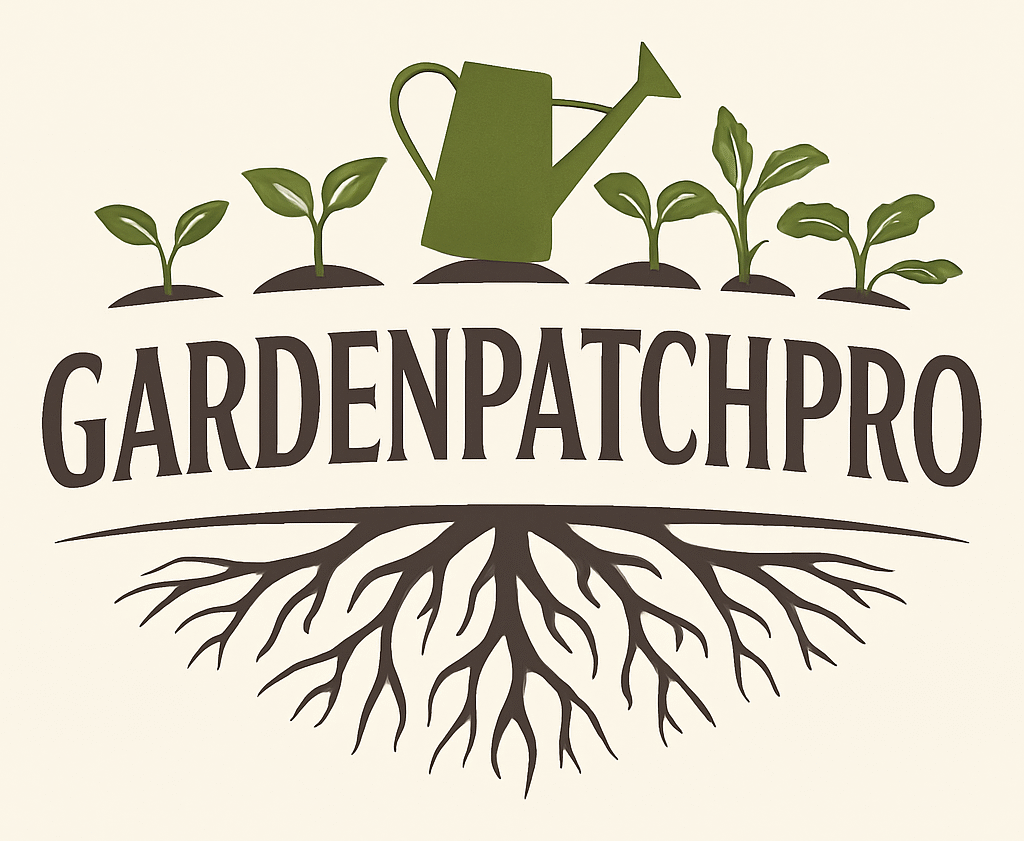What’s Wrong With My Plant? Identify, Diagnose, and Fix Common Issues
Plants show problems in many ways, from curled leaves to yellowing or sticky surfaces. Most issues come down to watering mistakes, pests, or lighting problems. Understanding these common signs helps people fix their plants quickly and keep them healthy.
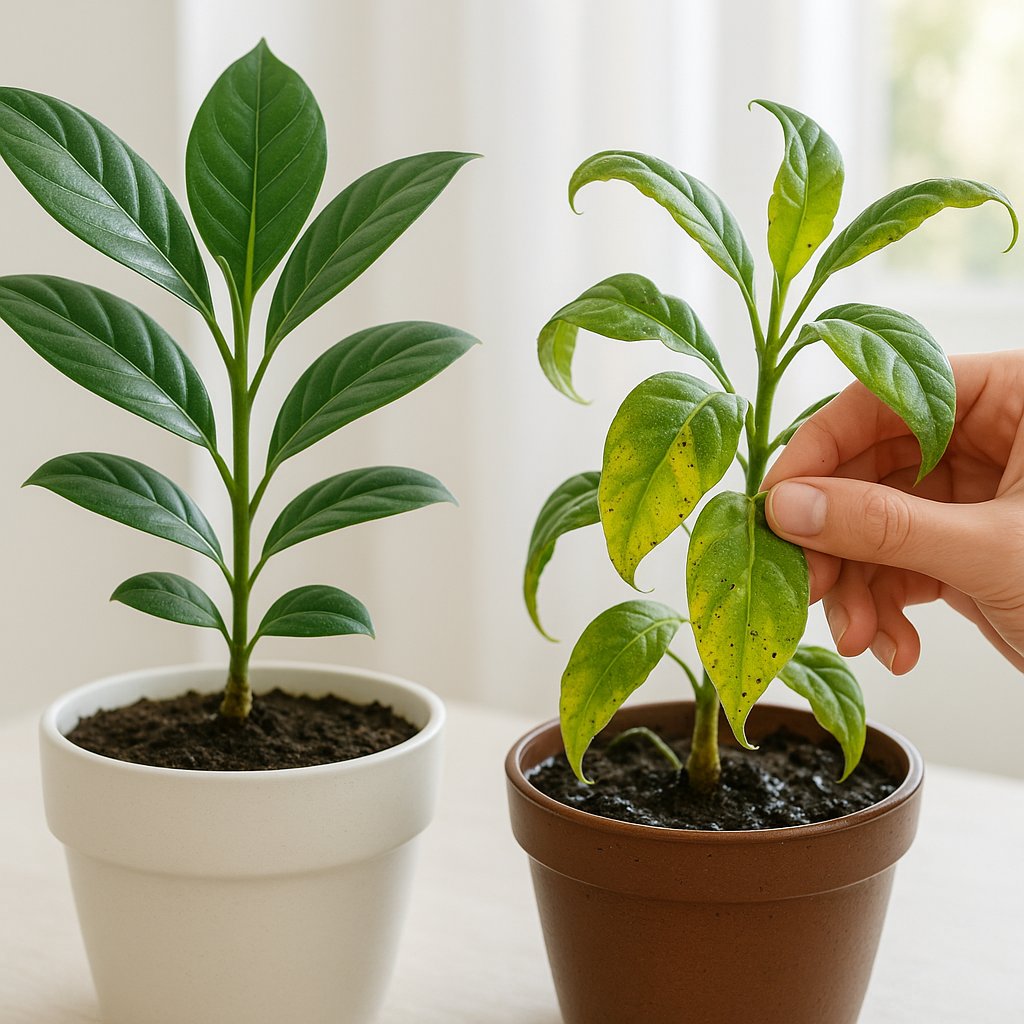
Sometimes, plants suffer because the soil is too wet or too dry. Other times, tiny bugs or diseases cause damage. Environmental factors, like drafts or low humidity, can also make a plant struggle. Knowing what to look for is key to giving the right care.
This article will guide readers through easy steps to identify what’s wrong and how to fix it. With the right attention, many plant problems can be solved before they cause lasting harm.
Key Takeways
- Identifying common plant problems starts with observing changes in leaves and soil.
- Proper watering and good light exposure are essential for plant health.
- Pests and environment issues can often be controlled with simple care adjustments.
Recognizing Signs of Plant Distress

Plants often show clear physical signs when something is wrong. Changes in leaves and growth patterns can reveal issues with water, pests, or disease. Paying attention to wilting, color changes, and growth speed helps diagnose problems early to keep plants healthy.
Spotting Wilting and Drooping Leaves
Wilting or drooping leaves usually signal a problem with water or roots. If the soil is dry and leaves droop, the plant likely needs more water. However, wilting can also come from overwatering, which causes root rot and prevents the roots from taking up moisture.
Drooping can also result from extreme temperatures or poor drainage. Wilting leaves that do not recover after watering often indicate deeper root damage or disease. Checking soil moisture and root health helps determine the cause quickly.
Identifying Yellowing Leaves
Yellow leaves are a common sign of stress in plants. This can happen from underwatering or overwatering, nutrient deficiencies, or poor light conditions. If yellowing starts at the leaf tips and spreads inward, it often means the plant is not getting enough water or nutrients.
A yellow color evenly across older leaves might indicate a nitrogen deficiency. Yellow patches combined with brown edges suggest the plant is stressed by too much direct sunlight. Regularly checking soil moisture and adjusting light can prevent yellowing problems.
Understanding Brown and Black Spots
Brown or black spots on leaves usually point to fungal infections, pests, or physical damage. These spots may have a yellow halo or irregular edges, which are common signs of leaf spot disease. Fungal infections thrive in wet, humid conditions.
Pests such as spider mites or aphids can cause similar discoloration by feeding on the leaves. Brown or black patches can also appear when leaves burn from too much sun or are damaged by chemicals. Identifying the exact cause helps decide if treatment with fungicide, pest control, or changing environment is needed.
Noticing Slow or Stunted Growth
Slow or stunted growth means the plant isn’t developing as expected. This often points to root problems, lack of nutrients, or poor lighting. If new leaves are smaller than usual or growth stops, the plant may be stressed.
Other factors like compacted soil or too-small pots can limit root expansion, causing slower growth. Root damage from pests or disease also reduces nutrient uptake. Improving soil quality, repotting, and adjusting care routines supports healthier development.
Watering Problems and Root Health

Watering directly affects a plant’s health, especially its roots. Too much or too little water can cause stress, wilting, and damage to roots. Knowing how to recognize watering issues and checking soil moisture helps keep plants healthy. Problems like root rot and becoming root bound often start with improper watering or pot size.
Recognizing Overwatering Symptoms
Overwatering can make roots sit in water, cutting off oxygen. This leads to root rot and weak plants. Common signs include yellowing leaves, which may drop early. The soil often feels soggy or stays wet for days. Leaves may wilt even when the soil is wet, which confuses many growers.
Overwatering also causes slow growth and a faint rotten smell from the soil. It’s important to test soil moisture before watering. Using well-draining soil and pots with drainage holes helps prevent this problem.
Signs of Underwatering
Underwatering leaves plants wilting and stressed. When roots don’t get enough water, the leaves turn dry, brown, or crispy, often starting at the edges. The soil pulls away from the pot edges and feels dry two inches below the surface. Plants may stop growing or drop leaves as a survival response.
A plant lacking water will look weak and lifeless but watering deeply usually revives it. It helps to water until water drains from the pot’s bottom, ensuring moisture reaches the roots. Adjusting the watering schedule for heat or dry conditions can prevent this.
Checking Soil Moisture
Checking soil moisture is crucial before watering. The easiest method is the “finger test.” Stick a finger about one inch into the soil. If it feels dry, watering is needed. If it still feels moist, wait before watering again.
More precise tools like moisture meters measure water content deeper in the soil. This avoids watering too often or not enough. Different plants have different moisture needs, so testing helps tailor watering to each species. Soil type also affects moisture-retaining ability; sandy mixes dry faster than those with more organic matter.
Identifying Root Rot and Root Bound Issues
Root rot happens when roots stay wet too long, causing tissue to decay. Affected roots look brown and mushy, unlike healthy white roots. Plants with root rot wilt despite wet soil and may emit a bad odor. Poor drainage or overwatering are common causes.
Root bound plants grow too large for their pot. Roots circle tightly around the pot’s edges and may grow out of drainage holes. This restricts water absorption and causes wilting or stunted growth. Repotting into a larger pot with well-draining soil solves these issues and supports healthy root growth.
Common Houseplant Pests and Infestations
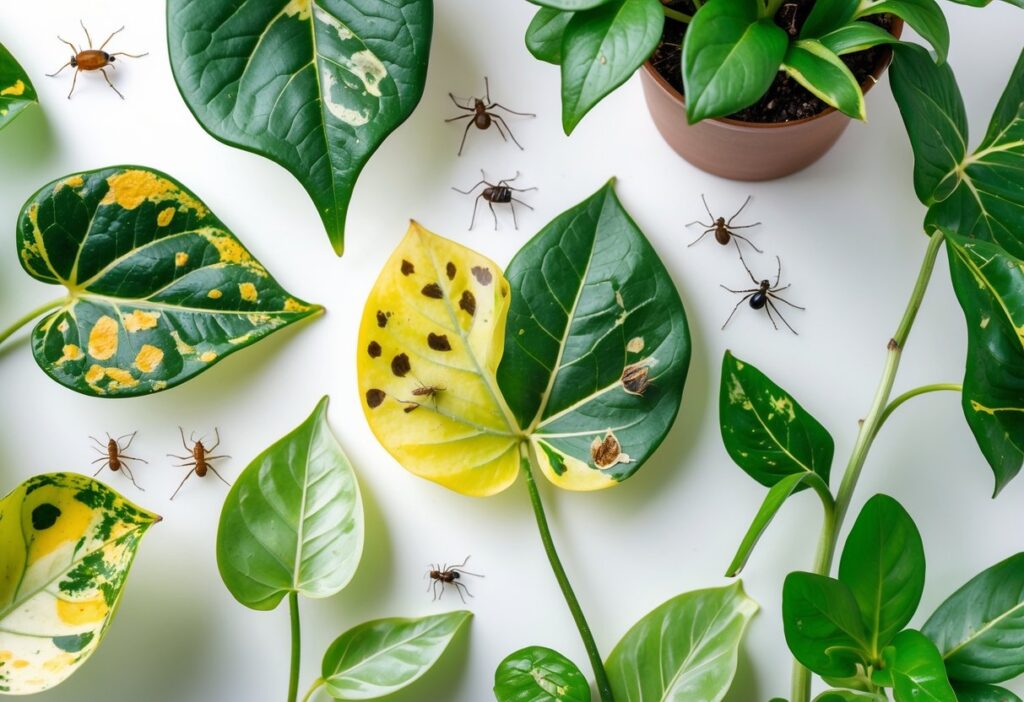
Houseplants are often affected by small pests that feed on their leaves, stems, and roots. These pests can cause damage like yellowing leaves, stunted growth, and sticky residue. Spotting and treating these infestations early can save the plant from serious harm.
Spotting Aphids, Mealybugs, and Scale Insects
Aphids are small, soft-bodied insects that usually cluster on new growth and undersides of leaves. They suck sap, causing leaf curling, yellowing, and stunted growth. Aphids leave behind a sticky substance called honeydew, which can attract mold.
Mealybugs look like tiny white cottony spots. They hide in leaf joints and stems, feeding on plant sap. Their waxy coating protects them, making them tough to remove. Mealybug infestations cause yellow leaves and weak growth.
Scale insects appear as small bumps on stems or leaves. They are stationary and covered with a hard or waxy shell. Scale feeding also produces honeydew. Removing scale requires careful wiping or pruning of heavily infested areas to prevent spread.
Detecting Spider Mites, Mites, and Webbing
Spider mites are very small and often go unnoticed until damage shows. They leave tiny yellow or bronze spots on leaves and fine webbing over the plant. Warm, dry conditions encourage their growth.
Other mites like cyclamen and broad mites cause distorted, pale, or bronze leaves. These pests feed in hidden spots, so damage might appear before spotting the mites.
Webbing is a clear sign of spider mites. Treatment includes washing the plant with water or miticides and improving humidity around the plant to discourage the mites.
Identifying Fungus Gnats and Whiteflies
Fungus gnats are tiny flying insects that hover around the soil. Their larvae feed on roots, causing weak growth and sometimes root damage. Overwatering encourages fungus gnats.
Whiteflies are small white insects that fly up when the plant is disturbed. They feed on leaf undersides, leading to yellowing and dropping leaves. Like aphids, whiteflies produce honeydew, which encourages mold.
Sticky yellow traps can help catch adult fungus gnats and whiteflies. Reducing watering and planting in well-draining soil also limits their numbers.
Managing Tiny Bugs and Pest Infestation
Many tiny bugs like thrips and leaf miners injure plants by feeding inside leaves or on sap. These pests often cause spotted or distorted leaves and reduced growth.
To manage these infestations, regularly inspect plants, especially new ones. Removing affected leaves, using insecticidal soaps, or applying natural predators can control most tiny pests.
Isolating infested plants prevents pests from spreading to healthy ones. Maintaining healthy care routines reduces the chance of infestations becoming severe.
For more on dealing with pests, see this guide to common houseplant pests and removal.
Fungal, Bacterial, and Viral Plant Diseases
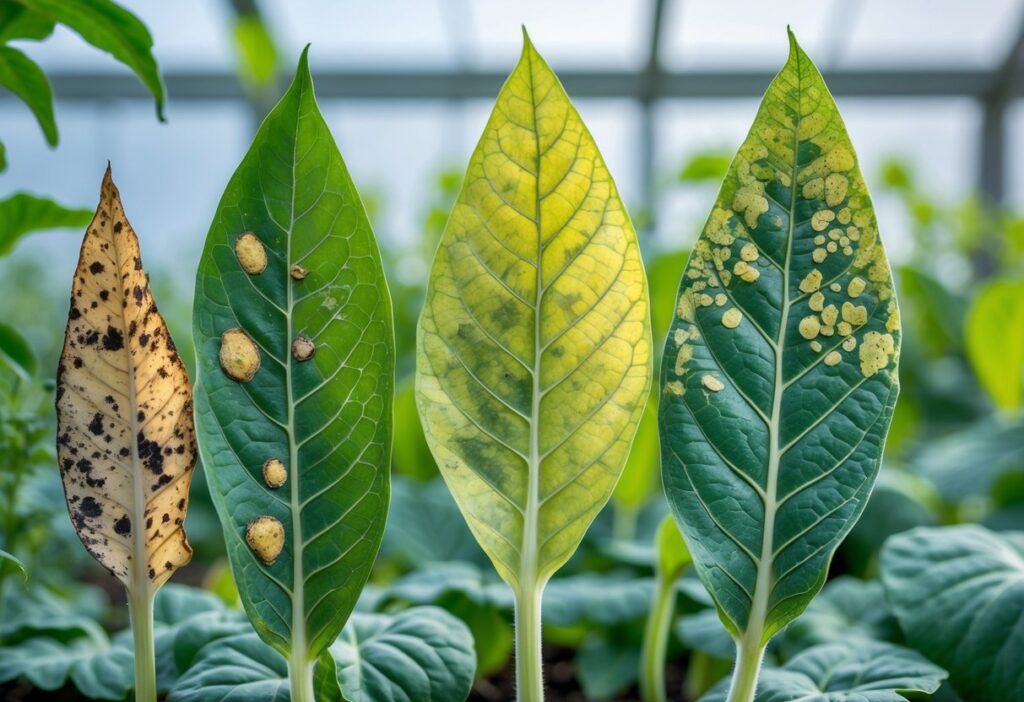
Plants can be harmed by different types of pathogens, mainly fungi, bacteria, and viruses. These cause visible symptoms like spots, mold, or wilting. Each type has unique signs that help in early detection and treatment.
Recognizing Fungal Infections and Leaf Spot
Fungal infections often show up as distinct spots or patches on leaves. These leaf spots can be round, irregular, or angular with sharp edges. They often have dark centers or rings and may cause yellow halos. Fungi thrive in moist environments, making wet leaves a common site of infection.
Symptoms include leaf yellowing, curling, or dropping, which reduce the plant’s ability to photosynthesize. Common fungal diseases with leaf spots include anthracnose and leaf blight. These fungi reproduce using spores often spread by wind or water.
Treating fungal infections usually involves removing affected parts and applying fungicides. Improving air circulation and avoiding overhead watering can help prevent leaf spot from spreading.
Identifying Signs of Powdery Mildew and Anthracnose
Powdery mildew appears as white or gray powdery patches on leaves, stems, and buds. This fungal disease prefers warm, dry areas with high humidity. It starts with small spots that grow and merge, eventually covering large plant parts.
Anthracnose causes dark, sunken lesions often on leaves, stems, fruits, or flowers. It can lead to leaf drop and fruit rot. This disease spreads in wet conditions when fungal spores move by rain splash or irrigation.
Both diseases weaken plants and reduce yield. Proper identification allows for timely treatment using fungicides designed to target fungal pathogens like powdery mildew and anthracnose.
Understanding Bacterial Infections
Bacterial infections in plants cause water-soaked spots that often turn dark and spread quickly. Some leaf spots have a yellow halo around the infected area. In severe cases, bacterial infection leads to wilting, oozing of sticky substances, or cankers.
Common plant bacterial diseases include bacterial leaf spot, crown gall, and bacterial blight. Bacteria often enter through wounds or natural openings like stomata. Once inside, they multiply and destroy tissue.
Unlike fungi, bacterial infections cannot be treated with fungicides. Infected plants often must be removed to prevent spread. Good hygiene, sterilizing tools, and avoiding overhead watering reduce the risk of bacterial infections.
For more on fungal, bacterial, and viral plant diseases, see Signs and symptoms of plant disease: Is it fungal, viral or bacterial or Common Plant Diseases Identification.
Troubleshooting Environmental and Nutrient Issues
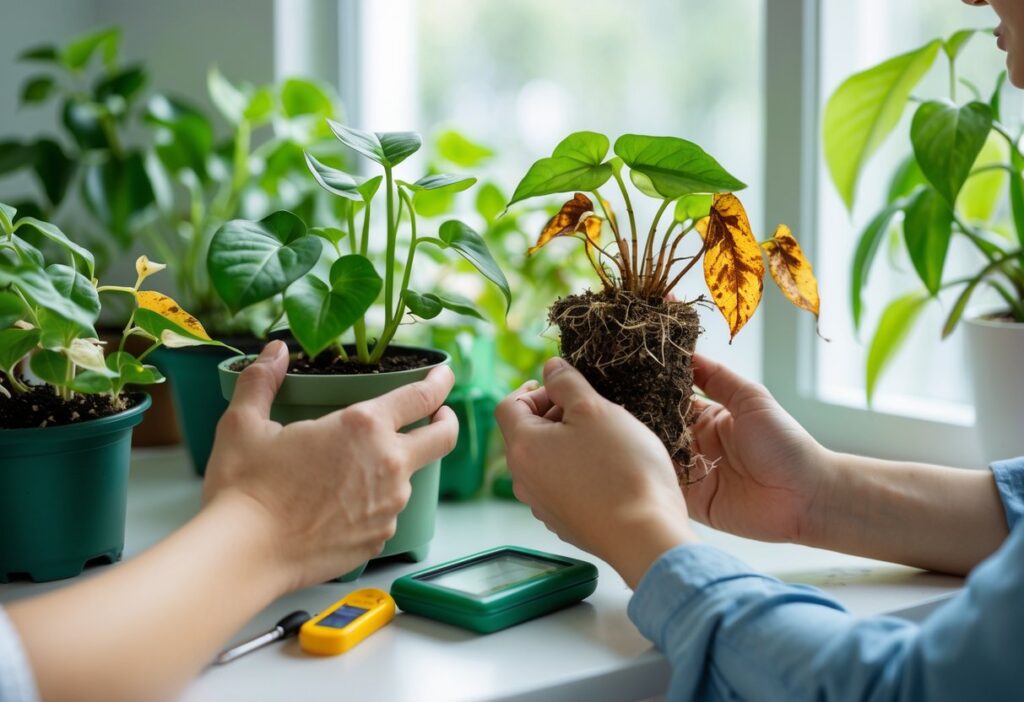
Environmental factors and nutrient balance play key roles in a plant’s health. Problems with sun exposure, nutrient shortages, or fertilizer misuse often show through visible signs like small leaves, discoloration, or poor growth. Careful observation and targeted adjustments help fix these issues effectively.
Diagnosing Sun Exposure Problems
Plants vary in their sun needs. Too much sun can cause leaf scorch, where leaves turn brown or crisp, especially at the edges. This often happens with plants placed in direct afternoon sunlight when they need partial shade.
Too little sun leads to weak stems, small or pale leaves, and slow growth. Shade-loving plants may suffer if placed in strong light, showing yellowing or leaf drop.
To diagnose, note the plant’s natural light preference. Check if leaves have dry spots or if growth is stunted. Adjust the plant’s location accordingly—move sun-sensitive plants away from windows with harsh light, or bring sun-loving plants closer to bright, indirect or direct sunlight.
Addressing Nutrient Deficiency
Nutrient shortages affect leaf color and size. Nitrogen deficiency causes yellowing leaves and small new growth. Iron deficiency results in yellow leaves with green veins, often on younger leaves.
Symptoms include leaf spots, discoloration, stunted growth, and sometimes leaf drop. Plants might also have thin, weak stems if nutrients are too low.
To address these issues, use a balanced fertilizer or supplements targeted to the lacking nutrient. Regular soil testing can identify deficiencies. Maintain proper watering, as overwatering can wash away nutrients while underwatering limits uptake.
Assessing Fertilizer Use
Over-fertilizing causes nutrient toxicity, stressing the plant and leading to yellow leaves, burned leaf edges, or slowed growth. Under-fertilizing results in slow growth, small leaves, and pale foliage.
It is important to follow the recommended fertilizer type and dosage for the specific plant. Applying fertilizer too often or using too strong a mix harms roots and foliage.
Flushing the soil with water can reduce excess fertilizer buildup. Plants need nutrients evenly and gradually, so steady, moderate feeding works best. Adjust fertilizer plans seasonally since many plants need less in winter.
For more on diagnosing nutrient issues, visit How to Diagnose and Fix Plant Nutrition Issues Quickly.
Solutions for Healthier Plants
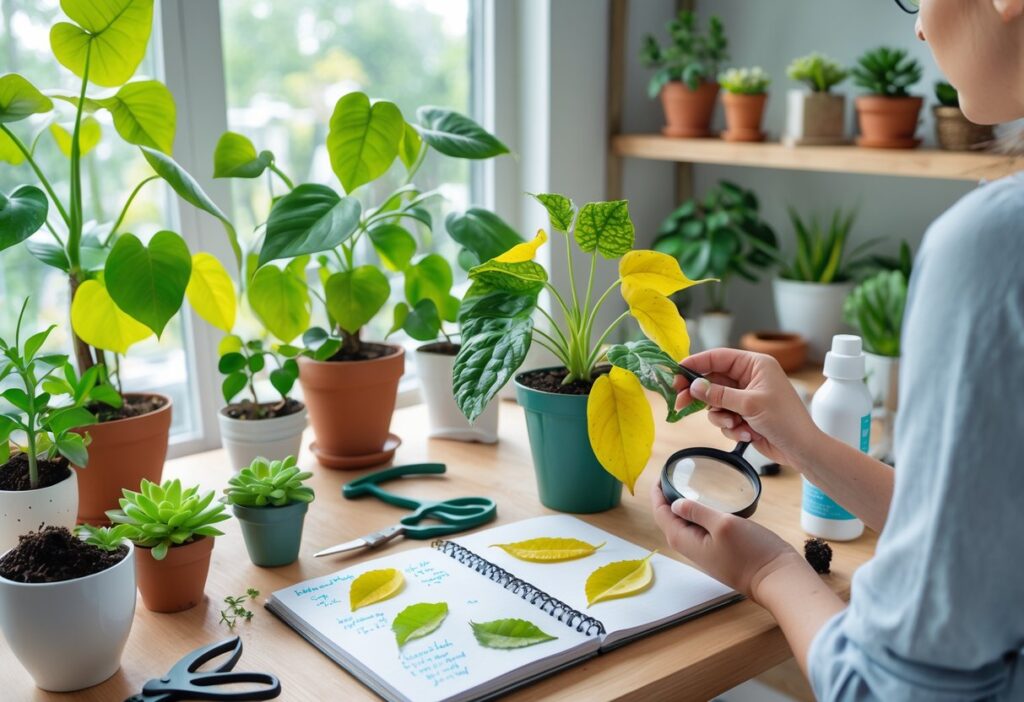
Proper care is key to fixing common plant problems like overwatering, pests, and diseases. Simple adjustments in watering, pest control, and disease management can bring plants back to health. Paying attention to soil and light also helps plants thrive.
Adjusting Watering Techniques
Watering should match a plant’s specific needs to prevent root rot or drought stress. It’s best to water only when the top 1/2 to 1 inch of soil feels dry. Using pots with drainage holes helps avoid standing water.
Well-draining soil is essential. It allows water to flow through without pooling, keeping roots oxygenated. If soil retains too much water, repotting with a mix designed for good drainage can help.
A consistent watering schedule avoids stress caused by irregular watering. Instead of following a strict time, check soil moisture before each watering. Flushing the soil occasionally can remove built-up salts from fertilizer or hard water.
Treating Pest Infestations
Common pests include spider mites, aphids, and scale insects. Checking leaves regularly for small bugs or sticky residue can catch infestations early.
Insecticidal soap and neem oil are effective treatments. Insecticidal soap kills pests on contact without harming the plant when used properly. Neem oil acts as both a pesticide and a mild fungicide, disrupting pests’ life cycles.
Spray the plant thoroughly, including leaf undersides. Repeat treatments every 7 to 10 days until pests disappear. Remove heavily damaged leaves to prevent spread and improve air circulation around the plant.
Managing Diseases with Fungicide and Neem Oil
Diseases like powdery mildew or leaf spots require prompt action to prevent spread. Removing infected leaves and increasing airflow can reduce fungal growth.
Fungicides target specific types of fungal infections. Use them following label instructions to ensure safety and effectiveness. Neem oil can also treat some fungal diseases and offers additional pest control benefits.
Avoid watering foliage. Water plants at the base to keep leaves dry. This limits conditions fungi need to thrive and helps protect new growth from infection.
General Care and Prevention Tips
Light, humidity, and cleanliness play major roles in plant health. Providing bright, indirect light prevents weak or leggy growth. Rotate plants to ensure even light exposure.
Maintaining proper humidity, especially for tropical plants, reduces leaf browning and pest stress. A humidifier or pebble tray helps increase moisture around the plant.
Clean pots and tools after use to stop the spread of pests and diseases. Remove dead leaves and debris regularly to keep the area tidy and reduce breeding grounds for problems.
Regularly inspect plants to catch issues early. Combining these care habits with proper watering, pest, and disease management leads to stronger, healthier plants. For more detailed fixes, visit What’s Wrong with My Plant? How to Fix 10 Houseplant Problems.
Frequently Asked Questions
Plants show many signs when something is wrong. Changes in leaf color, spots, or wilting can point to specific problems like watering, pests, or nutrients.
Why are my plant’s leaves turning yellow?
Yellow leaves can mean overwatering or poor drainage. It might also indicate nutrient shortages or root issues. Sometimes, too much direct sunlight causes yellowing as well.
How can I identify nutrient deficiencies in my plant?
Look for patterns like pale leaves, spots, or stunted growth. For example, yellowing between veins may show a lack of iron, while older leaves turning yellow might suggest nitrogen deficiency.
What are the common signs of overwatering in plants?
Overwatered plants often have yellow, wilted leaves and soggy soil. A bad smell from the soil can mean root rot. The leaves may also feel soft or limp.
How can pest infestations be detected in indoor plants?
Check the undersides of leaves for holes, sticky residue, or tiny insects. Webbing or small white spots can show spider mites or scale insects. Early detection helps prevent serious damage.
What conditions cause brown spots on plant leaves?
Brown spots often happen from too dry soil, overwatering, or fungal infections. Leaf edges turning brown can also mean low humidity or salt buildup in the soil.
Why is my potted plant wilting despite regular watering?
Wilting can occur if roots are damaged or if the plant is root-bound. Poor drainage or compacted soil can also prevent water from reaching roots properly, causing wilting despite watering.
